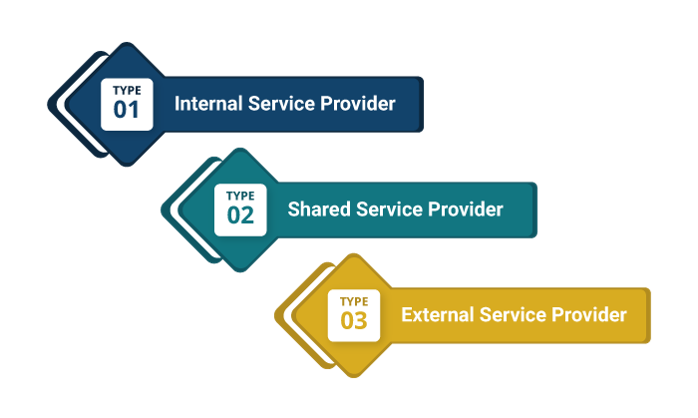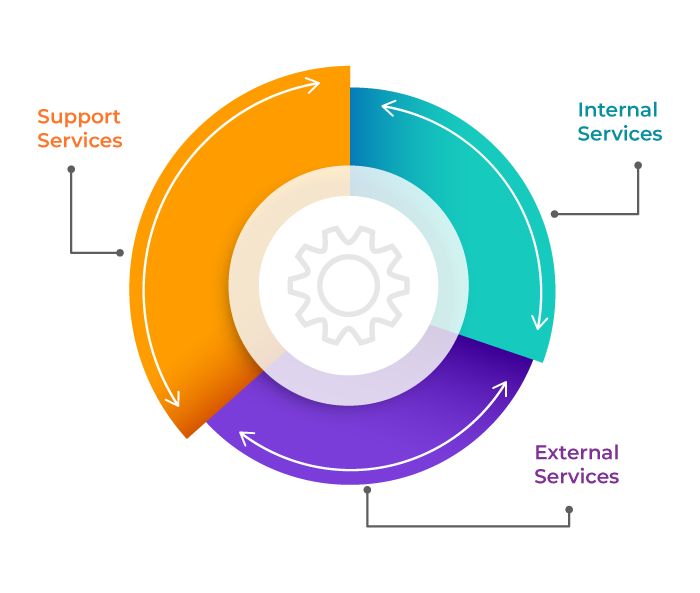
The ITIL service providers and service portfolio are the two phases of the same coin. While one of them takes care of the supply of services between the internal and the external customers, the other makes sure there is an efficient mix of services that will support the entire service strategy. Let’s try to understand each of the ITIL Service Strategy and Service portfolios in detail.
ITIL Service Providers
The service provider is an organization that provides IT support services to internal and external customers.
There are 3 types of ITIL service providers:
ITIL Service Providers: Internal Service Provider (Type I)
Internal service providers exist in an organization to deliver IT services to a particular unit only.
-
-
Since they are attached to a particular unit, they can dedicate their time and resources to providing the best possible support to the business unit.
-
They will also be more familiar with the requirements and problems of the business unit and can solve them faster.
-
The managers of the business unit have everything under their control.
-
The transactions are more transparent, and the costs are under the direct control of the management of the business unit.
-
If the company has multiple business units, this type of service provider will exist for each unit, thereby creating duplication of manpower and resources.
-
There is a higher risk of market failure associated with Type I service providers as they serve a single business unit and have nothing to fall back on, in case things don’t go the right way in the business unit.
-
ITIL Service Providers: Shared Service Provider (Type II)
Shared service providers deliver IT services to multiple units in the same organization.
-
-
They eliminate duplication of personnel and resources as they provide IT services to several business units across the organization.
-
Each business unit ends up spending less on maintaining the IT service provider as the costs are spread across several business units.
-
Since shared service providers have a heavy workload and have to keep costs to a minimum, their equipment can get outdated over time and replacements would be unlikely.
-
These service providers have to be flexible to cater to the varied needs of different business units. This prevents them from specializing in service.
-
ITIL Service Providers: External Service Provider (Type III)
External service providers deliver IT services to customers outside the organization.
In large organizations with multiple departments, it is usual to have a mixture of internal service providers and external service providers.
-
-
One of the main advantages of using an external service provider is that the company need not worry about capital investment such as the purchase and maintenance of equipment used by the service providers.
-
There is a fixed cost to be paid to the service provider, and the company does not have to worry about paying individual salaries or overtime as it is the duty of the service provider itself to manage that.
-
Businesses find it more flexible to use external service providers.
-
For a small business unit, it is economically not viable to invest in expensive IT equipment which would serve only limited roles. But outsourcing IT services is more cost-effective since it allows them to avail themselves of the benefits of the best equipment without paying for its ownership.
-
ITIL Service Portfolio
In ITIL, the service portfolio is the core information repository for all the services in an organization. The service portfolio describes the services which are presently being considered and developed by the service provider. This is in addition to its present contractual commitments; ongoing service improvement plans (SIPs) and the services which the company no longer provides.
A service portfolio is defined as the complete set of services that are managed by a service provider. The service portfolio is used to manage the entire lifecycle of all the services. It includes three categories:
-
Service pipeline (Proposed or under development)
-
Service catalog (live or ready for deployment)
-
Retired services
A service portfolio can also include third-party services which are used by the service provider as an integral component of the services it offers to its customers. A service portfolio portrays the commitments of a service provider and its investments across all its customers and market spaces in that the service provider operates or intends to operate in.
Internal service is a type of service which is delivered to the departments or business units in the same organization. External service is a type of service which is delivered to external customers who are outside the service provider’s organization.
There is a significant amount of difference between internal and external service as the former supports an internal activity and the latter achieves business outcomes. Internal services, however, have to be linked to external services for their contribution to be measured and understood.
Classification of Service Portfolio
By classifying services into ‘supporting,’ ‘internal’ and ‘external’ categories, it is possible for a service provider to differentiate between the services which actually support internal activity and the services which actually achieve business outcomes for customers.
They are classified as the following:
Support Services
-
-
They are services that are not used by businesses or external customers directly.
-
These services enable the IT processes and services used by the IT service provider to provide other services that are not directly visible to the customer.
-
The performance of the supporting service is managed by OLAs.
-
Supporting services are defined in a way to permits the interdependencies between IT components to be identified.
-
They show how the components are used to deliver internal and external customer-facing services.
-
Support services can exist so that they can be combined with other supporting services.
-
Internal Customer-Facing Services
-
-
They are the services which are directly supporting more than one business process that is being managed by an internal customer.
-
These services enable the IT processes and services used by the IT service provider to provide other services that are not directly visible to the customer. Internal customer-facing services are managed by SLAs and are underpinned by supporting services.
-
Internal customer-facing service is identified and defined by the business.
-
If a service cannot be perceived by the businesses it is engaged with; then it would be considered a supporting service and not a customer-facing one.
-
Internal customer-facing services depend on a set of integrated supporting services which are not visible to the customer.
-
Management of internal customer-facing services is done as per service level agreements.
-
External Customer-Facing Services
-
-
The services which are supplied by the IT department to external customers are called external customer-facing services.
-
These services are provided in a way to enable the organization to meet strategic objectives, which is why they are considered business services.
-
External customer-facing services are managed through a contract.
-
As per the organization’s strategy, the service is provided free or charged for.
-
Conclusion
The ITIL Service Providers and service portfolio makes sure the supply of services amongst the internal and external customers is efficient with enough services to support the entire service strategy in the organization. Learn more about such processes and best practices with ITIL 4 Foundation certification training and take your service management career to the next level.
Learn more about Service Management best practices through Invensis Learning’s IT Service Management certification training on ITIL V4 Foundation Course, SIAM Foundation, SIAM professional, VeriSM, etc.

















